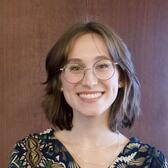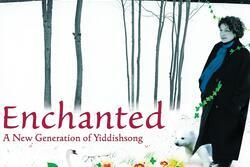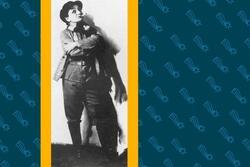Your Inner Child Will Thank You for Learning Yiddish
After two consecutive summers in the seven-week Steiner Summer Yiddish Program at the Yiddish Book Center, I feel more connected with my younger self than ever before. The inevitable result of this kind of educational program is language acquisition. However, the most valuable result from these two summers has been reconnecting with the playful, creative, imaginative energy of my inner child.
I grew up in a Hispanic-American household that hardly ever acknowledged our Jewish ancestry. When I finally became interested in finding Jewish community in college, I frequently felt excluded from the collective experiences that connected other young Jewish adults to their own identities. I know that I'm not alone in this feeling—I've heard from so many friends that missing out on things like Hebrew school and summer camp keeps them from feeling confident in Jewish institutional spaces as an adult.
I first became interested in Yiddish during my master’s program at the University of Massachusetts Amherst. As a scholar of Holocaust history, I thought Yiddish was the obvious choice for completing my language requirement. With the Yiddish Book Center only a ten-minute drive away from my apartment, I figured it would be my best bet for a summer program. On the first day of the program I was transported to “Yiddishland,” a metaphorical place encompassing all linguistic and cultural spaces where Yiddish is used. In “Yiddishland,” I could forget my research and enjoy the process of learning something completely new for the first time since childhood.
The Yiddish Book Center sits on the Hampshire College campus in bucolic western Massachusetts, surrounded by farms, forests, and lakes. As a Steiner student, I lived in the Hampshire dormitories with the other young adults in the program. Program activities frequently took place outside; whether walking through the woods or singing around the campfire, we always made good use of our beautiful home away from home. We jokingly called the program "Yiddish camp" after realizing how humid days and mosquito bites could be another uniting force for our small, closely-knit Jewish community. As someone who missed out on traditional Jewish summer camp as a kid, the Steiner Program unexpectedly gave me a foundational experience for navigating my Jewish identity in my mid-twenties.
While my younger self was fulfilled by finally going to summer camp, my current self had to dive into intensive language learning. Studying Yiddish involves a constant engagement with literature, poetry, art, and music. By working directly with historical and contemporary Yiddish sources, language students preserve Yiddish culture and connect with pedagogical materials on a deeper level. A regular day at the Yiddish Book Center might include translating a poem from the Warsaw Ghetto, watching a film starring gender-bending comedien Molly Picon, singing Jewish folk songs alongside contemporary Hasidic Electronic Dance Music (EDM), and discussing the artwork of Russian constructivist El Lissitzky. As a Yiddish student, I was exposed to the diversity and expansiveness of the ever-growing Yiddish cultural world.
During my first summer, I fell in love with Yiddish dance. As a kid, I danced competitively for about ten years, but lost my love for it when I left for college. During the Yiddish Book Center's annual summer music festival, Yidstock, I found out that Yiddish dance existed and was accessible to anyone. The young dancer inside me was absolutely delighted. Even before I could hold a conversation in Yiddish, my language teachers encouraged me to take the stage in a tanz varshtat (dance workshop). During our free time in the evenings, my classmates and I explored the local klezmer scene in Western Massachusetts and danced to the sounds of local bands like Burikes and Mamaliga. For the young dancer who was exhausted by competitions and team politics, Yiddish dance offered a return to what drew me to the art in the first place: joy and community.
Since the bittersweet end of my second (and final) Steiner summer, I have to make time for the creative projects that now spill out of me. A summer spent engaging with art, literature, and music every day sparked my own creativity in a way I haven't experienced since childhood. Books featuring art by cartoonist and puppeteer Zuni Maud and print-maker Arthur Kolnik inspired me to start making my own rubber stamps in a similar art style. Surprised by how much I enjoyed reading Yiddish poetry in class, I began seeking out English poetry to read before bed. Even the Yiddish literature assignments that tested my vocabulary (and my patience) during the summer left a positive mark on me—the voices of writers like Isaac Bashevis Singer and Chava Rosenfarb inspired me to return to writing fiction for the first time in years.
The first time I sat at my computer to write about “Yiddishland,” I was transported into a forgotten memory of my younger self. Curled into a corner of her bedroom, with blonde curls hiding her face deep in concentration, she scribbled relentlessly into a pink journal. She wrote dozens of stories of imagined children who lived in Warsaw and Paris, who had problems that felt as intimate as her own. Unburdened by the judgment that adulthood would bring, she created stories and art as if it were her sole purpose in life.
Now, as I write and dance and create in Yiddish, I feel her footprints underneath mine. I imagine that she was the first explorer on our personal journey with Yiddish, who mapped the places where I should return as an adult. Now we both enjoy summer camp. We both love to dance and we both make time to write, draw, and sing. Even as my last summer at the Steiner Program came to a close, I knew that she would stay with me to remind me that every day is an opportunity to be imaginative. I can say with confidence that she deeply thanks me for learning Yiddish.








My oh Maya, what a beautiful and touching piece of literature you've composed for us. As your grandfather, I couldn't be more thrilled, delighted and fulfilled in my own life's journey. Reading this piece of yours brings me full circle by tying up the knot that connects my parents and ancestors with your generation and the family progeny to come. It's a sort of paradox that, at age 93, I'm on the verge of completing what I hope will become a book. Its working title is "Undercover Jew," which gives you some idea of my need for fulfillment. More about that aspect when we meet again. Along with memories of my own Yiddish youth. For now let me just say that your discovery of a "Yiddishland" brings me nothing but satisfaction and joy.
With so many negative articles about being Jewish and loving Israel, This was an absolute pleasure to read. Thank you.
Thank you Maya!! Beautiful and inspirational
What a beautiful piece from Maya, who I had the wonderful opportunity to study with in an online Yiddish class last year and finally got a chance to meet (and dance with!) at Yidstock this summer. Yes, Maya. Yiddish does indeed bring out the inner artful child! Pure joy!